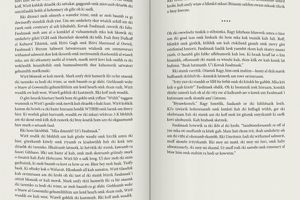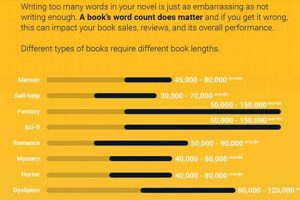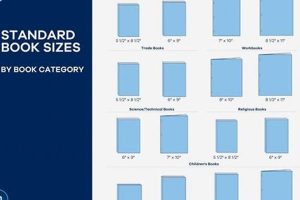Determining the ideal length of a published work is a multifaceted question, influenced by genre, target audience, and publishing conventions. The number of leaves bound together to form a literary piece can vary considerably. For instance, a children’s picture story may only require 32 leaves, while an epic fantasy saga could easily exceed 800.
Establishing an appropriate measure of physical content is significant for several reasons. It impacts production costs, reader perception, and market positioning. Historically, the physical constraints of printing technology and material availability played a crucial role in dictating the extent of written compositions. Today, while digital publishing offers greater flexibility, expectations regarding word count and overall size persist within different literary categories.
The following sections will delve into the typical ranges associated with various book types, examining the factors that contribute to these norms and providing guidance for authors aiming to meet the expectations of both publishers and readers.
Guidance on Determining Physical Extent
The physical extent of a manuscript is a crucial consideration for authors. Adhering to established norms within a given genre increases the likelihood of acceptance by publishers and positive reception by readers.
Tip 1: Research Genre Conventions: Examine successful works in the intended genre to ascertain typical lengths. Analyzing the physical makeup of comparable titles will provide a benchmark for the author’s work.
Tip 2: Consider Target Audience: The intended readership influences the advisable extent. Shorter formats may appeal to younger readers or those with limited time, while longer, more complex works may suit a more dedicated audience.
Tip 3: Prioritize Content: The narrative dictates the necessary quantity of leaves contained within the covers. Avoid artificial padding to meet a target; focus on delivering a compelling and well-paced story.
Tip 4: Consult Publisher Guidelines: Many publishing houses specify preferred leaf counts or word counts for different genres. Adhering to these guidelines demonstrates professionalism and increases the likelihood of consideration.
Tip 5: Seek Editorial Feedback: An editor can provide valuable insights into pacing and overall structure, helping to determine whether the composition is appropriately sized for its content and target audience.
Tip 6: Factor in Production Costs: The physical extent impacts printing expenses. Authors should be mindful of these costs, particularly if self-publishing, as they will directly affect profitability.
Thoughtful consideration of these factors will enable authors to create compositions of appropriate length, enhancing their chances of success in the marketplace.
The final section will address common misconceptions about ideal extent and offer practical advice on achieving a well-proportioned and satisfying literary piece.
1. Genre conventions
Genre conventions exert a significant influence on the physical extent of published works. The established norms within specific literary categories create reader expectations regarding length. Deviations from these norms can impact reader satisfaction and market acceptance. For example, the epic fantasy genre, typified by works like The Lord of the Rings or A Song of Ice and Fire, traditionally features substantial texts, often exceeding 700 leaves. This established convention shapes reader anticipation for complex narratives, extensive world-building, and multiple character arcs. A shorter fantasy piece might be perceived as less substantial or underdeveloped within that context. Conversely, a contemporary romance novel typically adheres to a lower physical extent, around 300-400 leaves. An overly lengthy romance could be seen as deviating from the genre’s focus on concise storytelling and emotional intimacy. Thus, adhering to or deliberately subverting genre-specific norms is a critical consideration.
The relationship between genre and physical extent also impacts publishing decisions. Publishers often have established guidelines based on genre, reflecting market research and an understanding of reader preferences. These guidelines may specify acceptable word counts or leaf counts for submissions. Submitting a manuscript that significantly deviates from these specifications can reduce its chances of acceptance. Furthermore, marketing and distribution strategies are often tailored to genre conventions. For example, mass-market paperbacks, typically associated with genres like thrillers and mysteries, often have a lower physical extent than hardcover editions of literary fiction. Understanding these publishing realities is crucial for authors seeking to navigate the industry effectively. Consider science fiction, where authors like Isaac Asimov established that longer stories can explore themes more deeply, creating an unwritten rule for the genre, while shorter works are often marketed as “hard science fiction”.
In summary, genre conventions operate as a framework that shapes expectations. Authors must understand how these conventions inform reader preferences and publishing practices. While creative license allows for departures from established norms, a conscious awareness of these conventions is vital. Failure to address genre-specific expectations can negatively impact the reception and commercial viability of a work. Adhering to or strategically subverting these conventions requires a thorough understanding of the target genre and its audience.
2. Target audience
The intended readership exerts a considerable influence on the appropriate physical extent of any published work. The age, reading habits, and expectations of the target demographic directly correlate with the suitable magnitude. A children’s book, for instance, necessitates brevity and simplicity, typically falling within a range of 24 to 48 leaves, characterized by large print and abundant illustrations. This contrasts sharply with academic texts, which often extend to several hundred leaves, accommodating extensive research, detailed analysis, and comprehensive referencing. The effect of matching magnitude to the expected readership cannot be overstated.
For young adult (YA) literature, which targets teenagers and young adults, the prevailing length tends to range from 250 to 400 leaves. This number balances the need for engaging narratives with the reading stamina and time constraints of the target audience. Genre-specific conventions within YA also play a role, with fantasy or science fiction titles often leaning towards the upper end of this range to accommodate complex plotlines and world-building. Adult fiction exhibits the widest range, varying from concise literary novels around 200 leaves to sprawling epics surpassing 500. This variation reflects the diverse tastes and reading preferences of the adult market. An effective analysis involves evaluating the maturity, prior literary exposure, and reading habits of the intended recipients. A novel aimed at casual readers might benefit from a more accessible, shorter composition, while a work targeting seasoned literary enthusiasts could accommodate greater complexity and depth, thus justifying an expanded physical extent.
Ultimately, aligning the physical dimensions of a piece with the expectations and preferences of the target audience increases its likelihood of engagement and positive reception. Authors must carefully consider the characteristics of their intended readers and tailor the physical size accordingly. Misalignment can lead to reader dissatisfaction, reduced sales, and negative critical feedback. Therefore, audience consideration stands as a crucial factor when establishing appropriate volume.
3. Narrative scope
The breadth and depth of a narrative directly influence the physical extent of a manuscript. A narrative scope encompassing multiple complex plotlines, extensive character development, and elaborate world-building necessitates a greater quantity of pages to fully realize its potential. Conversely, a focused narrative, concentrating on a single storyline with limited characters and a straightforward setting, can effectively convey its message within a more concise format. The interdependence of narrative ambition and physical size is critical for creating a balanced and satisfying work. Attempts to condense a sprawling narrative into an insufficient quantity of pages often result in a rushed and underdeveloped story, sacrificing crucial details and weakening the overall impact. Conversely, stretching a simple narrative across an excessive number of pages can lead to pacing issues, unnecessary repetition, and reader disengagement.
Examples of this relationship are readily apparent in literature. Leo Tolstoys War and Peace, with its sprawling depiction of Russian society during the Napoleonic Wars, demands its considerable length to accommodate the multitude of characters, interwoven storylines, and thematic explorations. Similarly, J.R.R. Tolkiens The Lord of the Rings requires its extensive page count to fully realize the complex world of Middle-earth and the epic journey of its characters. In contrast, Ernest Hemingways The Old Man and the Sea achieves its profound emotional impact through a concise and focused narrative, demonstrating that a limited scope can be equally powerful when executed with precision. The practical significance of understanding this relationship lies in the authors ability to accurately assess the needs of the story and adjust the physical extent accordingly. This assessment involves carefully considering the complexity of the plot, the number of characters, the level of detail in the world-building, and the thematic depth of the exploration. A thorough evaluation of these elements will guide the author in determining the appropriate size, ensuring that the story has sufficient space to unfold naturally without becoming either overwhelming or underwhelming.
In summary, the narrative scope stands as a fundamental determinant of the proper physical length. A clear understanding of the story’s complexity, character development, and thematic ambitions is essential for determining the appropriate quantity of pages. While challenges may arise in balancing narrative ambition with reader expectations and publishing constraints, a careful consideration of these factors will ultimately result in a well-proportioned and satisfying literary piece. The key is ensuring the physical dimensions serve, rather than hinder, the narrative’s potential.
4. Production cost
The physical size directly influences production expenses. A higher number of leaves correlates with increased material consumption, primarily paper and ink, and subsequently escalates printing expenditures. Binding method, paper stock selection, and the presence of illustrations further compound these costs. Consequently, the decision regarding magnitude assumes significant financial implications, particularly for independent authors and smaller publishing houses operating with limited capital. A reduction in the number of leaves invariably results in lower printing expenditures, presenting an avenue for cost mitigation. This impact is particularly salient in print runs of substantial volume, where even minor adjustments to page count can yield significant savings. Furthermore, distribution costs are often calculated based on physical weight and dimensions; larger volumes incur higher shipping fees. The economic considerations necessitate a careful evaluation of quantity in relation to content necessity.
For self-publishing authors, the impact of production costs is particularly acute. Utilizing print-on-demand services mitigates some initial outlay, but per-unit expenses remain directly proportional to physical size. Consequently, minimizing unnecessary physical material becomes imperative to maintain profitability. Larger publishing houses possess the advantage of economies of scale, enabling them to absorb higher printing costs to a degree. However, even these organizations operate under budgetary constraints, necessitating a careful assessment of the cost-benefit ratio associated with each title. The presence of illustrations or color printing markedly increases printing fees, often necessitating adjustments to initial press runs or retail pricing. In summary, every element included directly in volume increase cost and must be carefully calculated.
In conclusion, the connection between printing costs and physical presence operates as a fundamental consideration in the publishing process. Financial viability often requires a delicate balance between narrative ambition and economic realities. While creative considerations undoubtedly hold importance, a practical understanding of production expenses enables informed decision-making, optimizing the financial sustainability of the endeavor. Balancing physical magnitude with artistic vision is essential to profitability.
5. Reader expectations
The interplay between reader expectations and physical extent represents a subtle but critical aspect of publication. Readers approach each literary work with preconceived notions shaped by genre conventions, author reputation, and marketing materials. These expectations significantly influence their perception of value and satisfaction.
- Genre-Based Expectations
Genre conventions create implicit agreements between authors and readers regarding narrative scope and complexity. Devotees of epic fantasy anticipate lengthy sagas with extensive world-building, while readers of contemporary romance typically expect shorter, more focused narratives. The perceived value diminishes if a book deviates significantly from these established parameters. A fantasy novel concluding in under 200 pages might be viewed as underdeveloped, while a romance novel exceeding 600 pages could be seen as verbose and self-indulgent. Such deviations risk alienating the target readership and negatively impacting reviews.
- Author Reputation
An author’s established reputation shapes reader expectations regarding scope and style. Readers familiar with an author known for concise prose and tightly plotted narratives may react negatively to a significantly longer and more digressive work. Conversely, an author celebrated for sprawling epics might disappoint readers with a short, minimalist composition. This aspect underscores the importance of maintaining consistency with an author’s established brand and understanding how physical size contributes to that brand identity.
- Price Point and Perceived Value
Physical presence influences the perceived value proposition. Readers often associate a higher purchase price with a larger physical manifestation, expecting a more substantial and complex reading experience. If the content fails to justify the magnitude, readers may feel shortchanged. This relationship is particularly relevant in the context of e-books, where physical materiality is absent, and readers rely solely on word count or leaf count as an indicator of content value. Publishers must carefully calibrate pricing strategies to align with perceived value based on physical extent.
- Reading Time Investment
Magnitude dictates the amount of time required to complete a book, influencing readers’ decisions to invest in a particular work. Readers with limited time may gravitate toward shorter, more easily digestible volumes, while dedicated readers seeking immersive experiences may prefer longer, more complex works. Authors and publishers must be mindful of the target audience’s time constraints and ensure that the physical presence aligns with their reading habits. Marketing materials should transparently communicate the approximate reading time required, allowing readers to make informed choices.
In summary, reader expectations operate as a powerful influence on the reception of any manuscript. A careful consideration of genre conventions, author reputation, price point, and reading time investment allows authors and publishers to tailor the physical extent to match reader preferences and maximize satisfaction. Failure to address these expectations can lead to disappointment and negatively impact the overall success of a book.
6. Marketability
The physical extent of a published work significantly influences its marketability, representing a key factor in its potential commercial success. Magnitude directly affects production costs, target audience appeal, and shelf placement, all of which contribute to overall market performance. A size perceived as too short may be viewed as lacking substance, while excessive magnitude can deter potential buyers due to the perceived time commitment and higher price point. Effective market positioning requires aligning the physical dimensions with established genre conventions and reader expectations, as a mismatch can negatively impact sales and critical reception. For instance, a debut fantasy novel exceeding 800 pages may struggle to find readership compared to a similar work within the 400-600 page range, demonstrating a direct cause-and-effect relationship.
Conversely, children’s literature necessitates brevity. Titles exceeding a standard leaf count are often rejected by publishers, as they fail to meet the needs of their intended audience. In non-fiction, a larger volume may signify greater expertise and comprehensiveness, but it also increases the risk of overwhelming readers. Self-help or business books, for example, often benefit from concise formats that offer actionable advice without requiring excessive reading time. The practical significance lies in the author’s and publisher’s ability to strategically position the work within its intended market segment. A well-executed market analysis informs decisions about physical dimensions, ensuring alignment with target reader preferences and competitive pricing strategies. Historical fiction novels, for instance, often command a higher extent due to the need for intricate world-building and detailed historical context. Publishers consider this factor when setting production budgets and marketing plans. Effective marketing campaigns highlight this “feature” (a larger size) or a “benefit” (comprehensive and extensive world building) when applicable.
In conclusion, the relationship between marketability and physical extent underscores the importance of understanding audience expectations and genre conventions. Successfully navigating this connection involves a strategic approach that balances creative ambition with commercial viability. Challenges arise when authors deviate significantly from established norms, requiring careful consideration of the potential impact on reader perception and sales. Prioritizing market analysis and aligning physical dimensions with audience preferences are critical for maximizing a book’s potential to achieve commercial success and positive critical reception.
7. Printing limits
Physical constraints inherent in the printing process directly influence the achievable leaf count. Technological limitations related to binding methods, paper stock thickness, and press capacity restrict the feasible range of sizes. Attempting to exceed these thresholds can result in compromised structural integrity, increased production costs, or outright printing infeasibility. Case binding, for instance, accommodates a wider range of sizes than saddle stitching, but entails a more complex and expensive manufacturing process. The chosen paper stock dictates the overall bulk; thicker, heavier stock increases the final thickness, potentially exceeding the binding machine’s maximum capacity. Print runs using digital printing, as opposed to offset lithography, may have size restrictions due to the handling of paper and the constraints of the machinery. The imposed physical constraints have significance in determining what magnitude of text is suitable.
Real-world examples illustrate the interplay between printing restrictions and leaf count determination. A childrens picture book using thick board stock is typically limited to a relatively small number of leaves to maintain a manageable thickness and weight for young readers. Art books and photography collections that demand high-quality paper may face size limitations due to the weight and cost of the selected material. Conversely, mass-market paperbacks often employ thinner, lower-cost paper, allowing for a higher leaf count within a compact format. Moreover, specific printing equipment may impose its own size restrictions. A printing press designed for standard book sizes cannot accommodate unusually large or small formats without significant modifications, thereby influencing leaf count possibilities. Understanding these restrictions is essential for maintaining both fiscal prudence and feasibility. It is important to also understand the minimum page count, and most printing limits affect how high of a page count is possible.
In summary, the restrictions serve as practical parameters within which all publishing decisions, including those of page count, are made. Technological limitations impose constraints on physical size, requiring alignment between narrative scope, printing capabilities, and budget considerations. Overcoming challenges requires a thorough understanding of these limitations and a willingness to adapt creative ambitions to the realities of the printing process. By carefully evaluating these factors, authors and publishers can navigate the inherent physical constraints and achieve a well-proportioned and commercially viable composition. The practical implications of understanding these restrictions cannot be overstated. Ignoring limits results in production problems, inflated costs, and ultimately, an unpublishable composition.
Frequently Asked Questions Regarding Physical Extent
The subsequent questions address common concerns regarding the determination of the extent in published compositions. These responses are intended to clarify misconceptions and provide guidance for those seeking to align their work with industry standards and reader expectations.
Question 1: Is there a definitive number of pages that constitutes the ideal physical presence?
No, no single leaf count universally applies across all written works. The optimal size is determined by genre conventions, target audience expectations, narrative scope, and economic considerations. A fixed number does not exist as a standard.
Question 2: Does a higher number of leaves automatically equate to a superior literary product?
No, magnitude is not a proxy for quality. A shorter, well-crafted narrative is often more impactful than an overly lengthy and poorly structured composition. The focus should remain on delivering a compelling and engaging reading experience, regardless of physical scale.
Question 3: Can a manuscript be readily elongated to meet a publisher’s desired extent?
Artificial expansion of a manuscript solely to satisfy a target can negatively impact pacing, introduce unnecessary repetition, and weaken the overall narrative. Content should dictate extent, not the reverse. Padding is almost universally frowned upon in professional writing.
Question 4: Should an author disregard genre norms when determining the appropriate physical presence?
While creative license permits deviations from established norms, disregarding genre conventions entirely can alienate readers and reduce the likelihood of market acceptance. A conscious understanding of genre expectations is essential, even when deliberately subverting them.
Question 5: How should one balance artistic vision with economic considerations?
Balancing artistic vision with economic realities requires careful evaluation of production costs, target audience expectations, and potential market performance. Compromises may be necessary to ensure financial sustainability, but should not unduly sacrifice the narrative’s integrity. Consider if you can get funding or investors.
Question 6: What is the role of an editor in determining the physical extent of a book?
An editor plays a crucial role in assessing the pacing, structure, and overall effectiveness of a manuscript. Their feedback can guide decisions regarding appropriate presence, ensuring that the narrative is neither rushed nor unnecessarily prolonged. Editors are often the determining factor when deciding how to best produce a writing piece.
In summary, the appropriate physical size represents a multifaceted decision-making process, requiring careful consideration of various factors. There are no definitive answers, and a balanced approach is essential to maximize a book’s potential for success.
The subsequent material transitions into more practical advice regarding common errors and helpful strategies for determining the appropriate scale.
Determining Composition Length
This exploration has elucidated the multifaceted nature of composition length. A definitive answer to “how many pages should be in a book” remains elusive, contingent upon genre conventions, target audience considerations, narrative scope, production costs, printing limitations, reader expectations, and overall marketability. A well-considered approach balances these factors, ensuring the final extent serves, rather than hinders, the work’s potential.
Authors and publishers alike must recognize that length is not a proxy for quality. A commitment to clear, concise storytelling, coupled with a thorough understanding of the target market, ultimately dictates a compositions success. Therefore, prioritizing content and audience will lead to a more impactful piece than arbitrarily meeting a certain extent.


![[Guide] How Many Words in a 300-Page Book? + Tips BoneyBooks | Discover Rare Books, Timeless Classics & Modern Reads Online [Guide] How Many Words in a 300-Page Book? + Tips | BoneyBooks | Discover Rare Books, Timeless Classics & Modern Reads Online](https://boneybooks.com/wp-content/uploads/2025/06/th-144-300x200.jpg)




